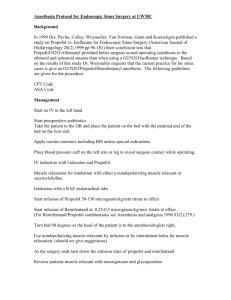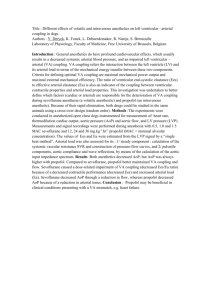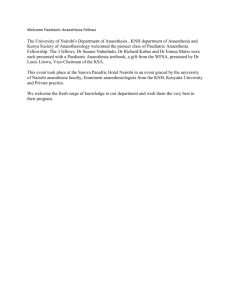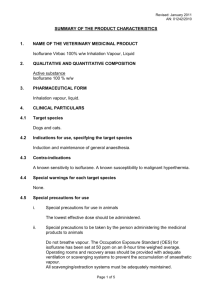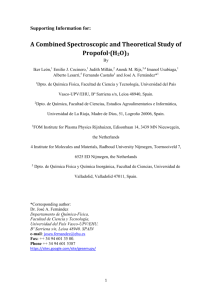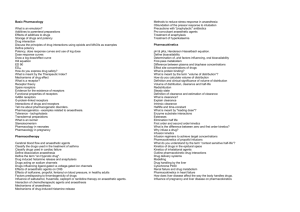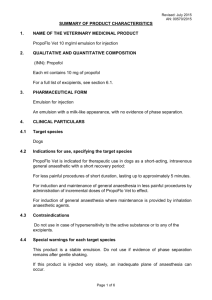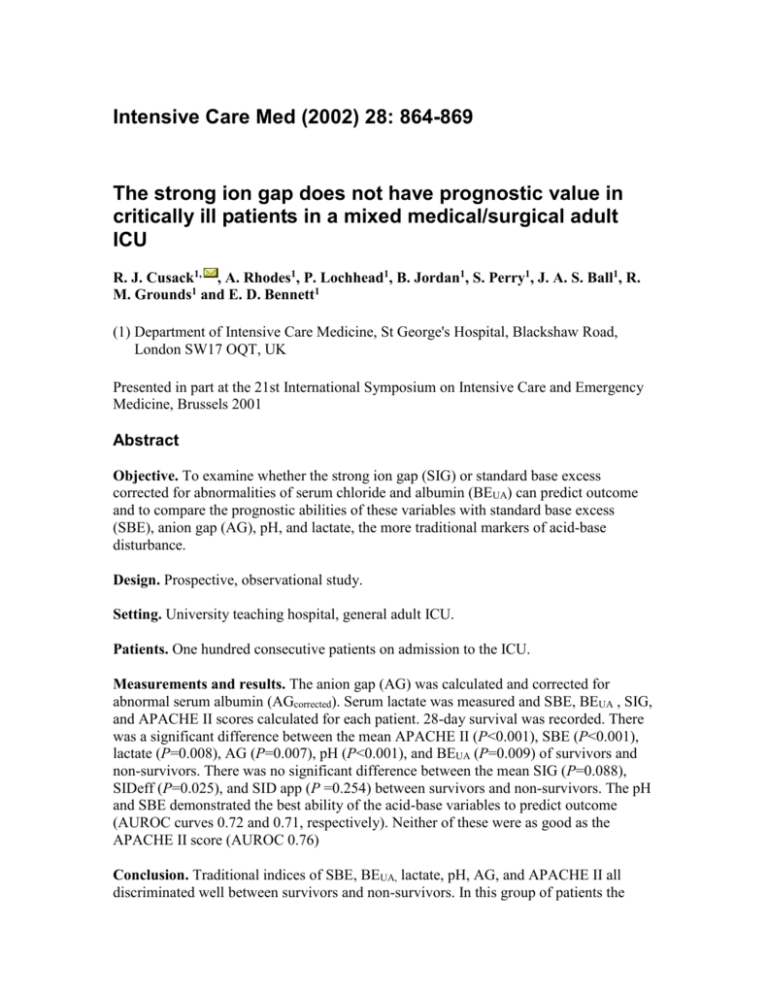
Intensive Care Med (2002) 28: 864-869
The strong ion gap does not have prognostic value in
critically ill patients in a mixed medical/surgical adult
ICU
R. J. Cusack1, , A. Rhodes1, P. Lochhead1, B. Jordan1, S. Perry1, J. A. S. Ball1, R.
M. Grounds1 and E. D. Bennett1
(1) Department of Intensive Care Medicine, St George's Hospital, Blackshaw Road,
London SW17 OQT, UK
Presented in part at the 21st International Symposium on Intensive Care and Emergency
Medicine, Brussels 2001
Abstract
Objective. To examine whether the strong ion gap (SIG) or standard base excess
corrected for abnormalities of serum chloride and albumin (BEUA) can predict outcome
and to compare the prognostic abilities of these variables with standard base excess
(SBE), anion gap (AG), pH, and lactate, the more traditional markers of acid-base
disturbance.
Design. Prospective, observational study.
Setting. University teaching hospital, general adult ICU.
Patients. One hundred consecutive patients on admission to the ICU.
Measurements and results. The anion gap (AG) was calculated and corrected for
abnormal serum albumin (AGcorrected). Serum lactate was measured and SBE, BEUA , SIG,
and APACHE II scores calculated for each patient. 28-day survival was recorded. There
was a significant difference between the mean APACHE II (P<0.001), SBE (P<0.001),
lactate (P=0.008), AG (P=0.007), pH (P<0.001), and BEUA (P=0.009) of survivors and
non-survivors. There was no significant difference between the mean SIG (P=0.088),
SIDeff (P=0.025), and SID app (P =0.254) between survivors and non-survivors. The pH
and SBE demonstrated the best ability of the acid-base variables to predict outcome
(AUROC curves 0.72 and 0.71, respectively). Neither of these were as good as the
APACHE II score (AUROC 0.76)
Conclusion. Traditional indices of SBE, BEUA, lactate, pH, AG, and APACHE II all
discriminated well between survivors and non-survivors. In this group of patients the
SIG, SIDeff, and SIGapp appear to offer no advantage in prediction of outcome and their
use as prognostic markers can therefore not be advocated.
Keywords. Strong ion gap - Standard base excess - Prognostic indicators - Acid-base
disturbance
PAIN®, Vol. 98 (3) (2002) pp. 269-275
© 2002 International Association for the Study of Pain. Published by Elsevier Science B.V. All rights
reserved.
PII: S0304-3959(02)00019-2
No pain, no gain: clinical excellence and scientific
rigour - lessons learned from IA morphine
Eija Kalso a * eija.kalso@helsinki.fi , Lesley Smith b, Henry J. McQuay b and
R. Andrew Moore b
a
Pain Clinic, Department of Anaesthesia and Intensive Care, Helsinki University
Hospital, P.O. Box 340, Helsinki FIN-00029 HUS, Finland
b
Pain Research and Nuffield Department of Anaesthetics, University of Oxford, Oxford
Radcliffe Hospital, The Churchill, Headington, Oxford OX3 7LJ, UK
Received 12 March 2001; received in revised form 19 December 2001; accepted 8
January 2002
Abstract
The effectiveness of intra-articular (IA) morphine in arthroscopic procedures of the knee
joint was analysed in all randomised and controlled trials that included injections of
morphine and placebo into the knee joint, and where the data were analysable. Sensitivity
of the studies and effectiveness were analysed for three different periods: immediate (02h), early (2-6h) and late (6-30h). Sensitivity for each period was assumed if pain
intensity was at least 30% of the maximum of 100 on the visual analogue scale in the
placebo group. Six different doses (1-10mg) of IA morphine were compared with
placebo. The injections were made at the end of surgery, before the arthroscope was
removed from the joint. In the immediate period 7/15 sensitive trials were positive, in the
early period 8/12 sensitive trials were positive and in the late period 10/13 sensitive trials
were positive. Most positive studies had used higher doses (3-5mg) compared with
negative studies that had mainly used 1mg. Two studies using patient controlled
analgesia consumption of analgesics as an outcome were also positive. The only sensitive
study of four dose-response comparisons indicated that 5mg of IA morphine was more
effective than 1mg. The only sensitive study of three cross-route comparisons showed no
difference between 5mg of IA and 5mg of intra-muscular morphine. All insensitive trials,
including placebo (except two individual comparisons), cross-route and dose-response
comparisons, were negative. The analysis of sensitive studies indicates that 5mg of IA
morphine injected into the knee joint provides postoperative pain relief for up to 24h. A
minimum of 30% of the maximum possible pain intensity is needed for an analgesic
effect to be detected in a study.
Keywords: Intra-articular; Knee joint; Morphine; Systematic review
*
Corresponding author. Tel.: +358-9-47175885; fax: +358-9-47175641
Intensive Care Med (2002) 28: 917-924
Influences on physicians' choices of intravenous
colloids
Michael S. Miletin1, Thomas E. Stewart1, 2,
and Peter G. Norton3
(1) Department of Medicine, University of Toronto, Mount Sinai Hospital, 600
University Avenue, Toronto, Ontario, Canada M5G 1X5
(2) Critical Care Medicine Programme, Critical Care Unit, Mount Sinai Hospital, 600
University Avenue, Suite 1818, Toronto, Ontario, Canada M5G 1X5
(3) Department of Family Medicine, University of Calgary, UCMC-Sunridge, 3465 26th
Avenue NE, Calgary, Alberta, Canada T1Y 6L4
Funding for this project was provided by Bayer Corporation, Biologic Products Division.
Abstract
Objectives. Controversy over the optimal intravenous fluid for volume resuscitation
continues unabated. Our objectives were to characterize the demographics of physicians
who prescribe intravenous colloids and determine factors that enter into their decision to
choose a colloid.
Design. Questionnaire with 61 items.
Participants and setting. Ten percent (n=364) of frequent intravenous fluid prescribers
in the province of Ontario, Canada.
Results. The response rate was 74%. Colloid use in the past year was reported by 79% of
the responding physicians. Important reasons for choosing a colloid included blood loss
and manipulation of oncotic pressure. Physicians tended to prefer either albumin or
pentastarch, but no important reasons were found for choosing between the two. Albumin
with or without crystalloid was preferred in 5/13 scenarios by more than 50% of the
respondents, whereas pentastarch was not favored by more than 50% of respondents in
any scenario. Physicians practising in critical care areas and teaching hospitals generally
preferred pentastarch to albumin. Physicians reporting pentastarch as representing greater
than 90% of total colloid use were more likely to have been visited by a drug detailer for
pentastarch than those who used less synthetic colloid (54 vs 22%, p<0.001).
Conclusions. The majority of physicians surveyed prescribe colloid products and the
reported use of albumin and pentastarch has a bimodal distribution. Although albumin
appeared to be preferred in more clinical niches, most physicians did not state reasons for
choosing between products. Marketing, specialty, location of practice and clinical
scenario appear to play significant roles in the utilization of colloid products.
Keywords. Questionnaire - Colloids - Albumin - Pentastarch - Intravenous fluids
(Chest. 2002;122:192-196.)
© 2002 American College of Chest Physicians
Use of Inspiratory Muscle Strength Training to
Facilitate Ventilator Weaning*
A Series of 10 Consecutive Patients
A. Daniel Martin, PhD, PT; Paul D. Davenport, PhD; Amy C. Franceschi, PT and
Eloise Harman, MD, FCCP
*
From the Departments of Physical Therapy (Dr. Martin), Physiological Sciences (Dr. Davenport), and
Medicine (Dr. Harman), University of Florida, Gainesville, FL, and the Department of Physical Therapy
(Ms. Franceschi), Shands Hospital at the University of Florida, Gainesville, FL.
Correspondence to: Daniel Martin, PhD, PT, Box 100154, Health Science Center, Gainesville, FL 32610;
e-mail: dmartin@hp.ufl.edu
Background and purpose: We instituted a low-repetition, high-intensity inspiratory
muscle strength training (IMST) program and progressively longer spontaneous breathing
periods (SBPs) in a group of medically complex patients who were dependent on
mechanical ventilation (MV) and had failed to wean.
Case descriptions: IMST was provided to 10 consecutive patients (four men, six women;
mean [± SD] age, 59 ± 15 years) who had failed to wean from MV by conventional
methods for 7 days. Prior to initiating IMST, patients had received MV support for a
mean of 34 ± 31 days. Daily IMST consisted of four sets of six breaths through a
threshold inspiratory muscle trainer that had been set at an intensity to yield an exertion
rating of 6 to 8 of a maximal value of 10. At the start of IMST, patients were tolerating
2.1 ± 3.4 consecutive hours of SBPs. The duration of the SBPs was increased daily, as
tolerated. Patients were considered to have been weaned from MV when they were able
to breathe without MV support for 24 consecutive hours.
Outcomes: After 44 ± 43 days of IMST, 9 of 10 patients were weaned from MV. The
initial IMST pressure was 7 ± 3 cm H2O, and it was increased to 18 ± 7 cm H2O (p <
0.05).
Discussion: These results indicate that an IMST protocol that produces significant
increases in threshold training pressure, in combination with progressive SBPs, aids in
weaning patients from MV. Although promising, these preliminary observations must be
tested in a controlled trial.
Key Words: respiratory muscle training • ventilator dependence • ventilator weaning
(Chest. 2002;122:140-145.)
© 2002 American College of Chest Physicians
Noninvasive Evaluation of Pulmonary Capillary Wedge
Pressure by BP Response to the Valsalva Maneuver*
Daniel Weilenmann, MD; Hans Rickli, MD; Ferenc Follath, MD; Wolfgang
Kiowski, MD and Hans Peter Brunner-La Rocca, MD
*
From the Division of Cardiology (Drs. Weilenmann, Rickli, Kiowski, and Brunner-La Rocca) and the
Department of Internal Medicine (Dr. Follath), University Hospital, Zurich, Switzerland.
Correspondence to: Daniel Weilenmann MD, Division of Cardiology, University Hospital, Petersgraben 4,
CH-4031 Basel, Switzerland; e-mail: dweilenmann@uhbs.ch
Study objectives: To determine the BP response to the Valsalva maneuver (VM) at
baseline and after changes in therapy and to compare this response to the invasively
measured pulmonary capillary wedge pressure (PCWP).
Design: Comparison of the BP response to the VM with invasively measured PCWP. In a
subset of patients, direct PCWP and pulse amplitude ratio (PAR) measurements were
repeated (mean ± SD) 3.2 ± 4.5 months later after adjusting the therapy.
Setting: Tertiary-care center.
Patients: Forty-two stable patients (8 women; mean age, 58 ± 13 years) undergoing right
heart catheterization who were in sinus rhythm.
Measurements: PAR calculated between the end and the beginning of the VM using the
last two beats and the first three beats of the straining phase and simultaneous
measurement of PCWP.
Results: There was a highly significant correlation between the invasively measured
PCWP (range, 2 to 32 mm Hg) and the PAR (range, 0.28 to 1.15; R2 = 0.75; p < 0.001).
In addition, changes of PCWP during follow-up (-16 to 13 mm Hg) were well-correlated
(R2 = 0.93; p < 0.001; n = 11) with changes in PAR (-0.44 to 0.47). The administration of
medication (eg, ß-blockers, amiodarone, angiotensin-converting enzyme inhibitor, and
digoxin) did not influence the results.
Conclusions: PCWP and changes during therapy can be estimated noninvasively by
measuring the PAR during the VM with acceptable accuracy in stable patients with
cardiac conditions. Thus, this method may be a useful tool in detecting an elevated PCWP
and hemodynamic response to therapy.
Key Words: congestive heart failure • pulmonary capillary wedge pressure • therapy •
Valsalva maneuver
Measurement and monitoring of neuromuscular
blockade
Aaron F. Kopman
Department of Anesthesiology, New York Medical College, at Saint Vincent Catholic Medical Centers,
Manhattan, USA
CURRENT OPINION IN ANAESTHESIOLOGY 2002;15:415-420
Purpose of review For more than three decades, ‘experts’ in the clinical pharmacology of
neuromuscular blocking agents have advocated routine intraoperative use of peripheral
nerve stimulators as monitors of neuromuscular function. This advice is far from
universally honored in practice. In part, this dichotomy between ‘accepted wisdom’ and
actual day-to-day practice may stem from a failure to provide the clinician with a
peripheral nerve stimulator that does not require subjective evaluation of evoked
responses. For 99% of anesthetists, the train-of-four fade ratio is a parameter that they
read about but cannot measure. This need no longer be the case.
Recent findings Small battery operated units are now available that are relatively
inexpensive, easy to set up, and provide objective measurement of the train-of-four ratio.
Although agreement between the output of these acceleromyographic and piezoelectric
sensors with such ‘gold standard’ technologies as mechanomyography and
electromyography is not absolute, it is probably adequate for clinical case management.
Summary It is my hope (and I have no financial interest in any of the cited devices) that
the present review will encourage further distribution of objective monitors of
neuromuscular function.
Keywords neuromuscular; monitoring; twitch; tetanus; train-of-four; nondepolarizing
block
Correspondence to Aaron F. Kopman, MD, Vice-Chairman, Department of Anesthesiology, New York
Medical College, at Saint Vincent Catholic Medical Centers, Manhattan, 170 West 12th Street (Room
NR408), New York, NY 10011, USA. Tel: +1 212 604 2636; fax: +1 212 604 2637; e-mail:
Akopman@rcn.com
Abbreviations
FEV1
FIV1
PNS
TOF
: forced expiratory volume in 1 s
: forced inspiratory volume in 1 s
peripheral nerve stimulator
train-of-four
Airway management outside the operating room
Joseph R. Brimacombea; Christian Kellerb
a
Department of Anaesthesia and Intensive Care, University of Queensland and James Cook University,
Cairns Base Hospital, Cairns, Australia and bDepartment of Anaesthesia and Intensive Care Medicine,
Leopold-Franzens University, Innsbruck, Austria
CURRENT OPINION IN ANAESTHESIOLOGY 2002;15:461-465
The choice of airway device for resuscitation depends on the skill of the user, the
equipment available, the conscious state of the patient, the location of the patient and the
probable cause of the cardiorespiratory arrest. Extraglottic airway devices are
recommended by the European and American Resuscitation Councils for use when
intubation skills are lacking. In this review, we discuss recent research relevant to the use
of extraglottic airway devices in resuscitation.
Correspondence to Professor J Brimacombe, Department of Anaesthesia and Intensive Care, University of
Queensland and James Cook University, Cairns Base Hospital, The Esplanade, Cairns 4870, Australia; Fax:
+61 7 40311628; e-mail: jbrimacombe@austarnet.com.au
Abbreviations
COPA
ETC
LMA
LTA
Cuffed Oropharyngeal Airway
Esophageal Tracheal Combitube
Laryngeal Mask Airway
Laryngeal Tube Airway
Acta Neurochirurgica
Table of Contents
Abstract Supplement 81 (2002) pp S89-S91
ICP is Lower During Propofol Anaesthesia Compared
to Isoflurane and Sevoflurane
K. D. Petersen, U. Landsfeldt, G. E. Cold, C. B. Pedersen, S. Mau, J. Hauerberg, and P.
Holst
Summary. Objectives. Propofol is a cerebral vasoconstrictor while inhalation
anaesthetics like isoflurane and sevoflurane act as cerebral vasodilators in both animal
and human studies. This difference of action upon cerebral vessels might implicate a
lower ICP during propofol anaesthesia. Cerebral metabolism is decreased by all three
anaesthetics. In a prospective, randomised multicenter study ICP was compared during
anaesthesia with propofol, isoflurane and sevoflurane.
Methods. 117 patients subjected to elective craniotomy for supratentorial tumour.
Propofol: N = 41; isoflurane: N = 38; sevoflurane: N = 38. Nitrous oxide was omitted and
all anaesthetics were supplemented with a continuous infusion of fentanyl. ICP was
measured subdurally after removal of the bone flap. MABP, CPP, PCO2, AVDO2, rectal
temperature, tumour size and midline shift were registered too. Statistics: Kruskal-Wallis
Variance on Ranks. All values in medians with range. P < 0.05 was considered
significant.
Results. ICP (mmHg): propofol 7 (1 –20), isoflurane 12 (1 –29), sevoflurane 11 (–32).
ICP was significantly lower in the propofol group compared to the isofluane and
sevoflurane groups. CPP (mmHg): propofol 80 (45 –104), isoflurane 60 (32 –84),
sevoflurane 63 (44 –77). CPP was significantly higher in the propofol group compared to
the isoflurane and sevoflurane groups. AVDO2 (mmol/l): propofol 3.1 (0.9 –5.1),
isoflurane 2.5 (1.1 –4.5), sevoflurane 2.6 (0.8 –4.1). AVDO2 was significantly higher in
the propofol group compared to the isoflurane and sevo-flurane groups. No significant
differences in PCO2, rectal temperature, tumour size and midline shift were found.
Conclusions. Subdural ICP is significantly lower during propofol anaesthesia compared
to isoflurane and sevoflurane anaesthesia. CPP and AVDO2 are significantly higher
during propofol anaesthesia compared to isoflurane and sevoflurane anaesthesia.
Keywords: Intracranial pressure, propofol, isoflurane and sevoflurane.

